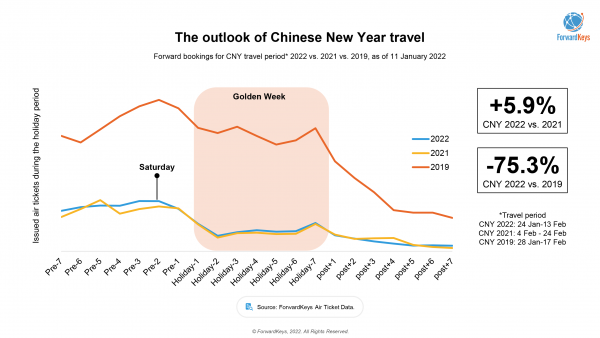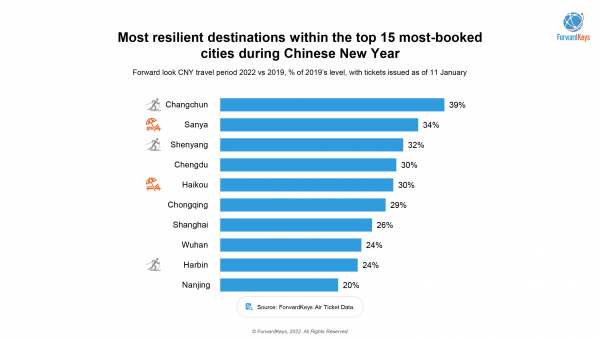SINGAPORE, 24 January 2022: Recent lockdowns in China, imposed in response to outbreaks of the Omicron variant, have cast a long shadow over new year travel plans, according to the latest report on travel trends by ForwardKeys.
The latest data up to 11 January shows flight bookings for the upcoming holiday period, 24 January to 13 February, were 75.3% behind pre-pandemic levels but 5.9% ahead of last year’s dismally low levels.

In addition to Omicron-related travel restrictions, government advice on Lunar New Year travel has also been an influential factor in dampening demand. Last year, many local authorities advised people to “stay put”. This year, the advice is a little more lenient, with people advised to protect their personal health while travelling, but not to “stay put”. That stance allows people the flexibility to wait and see how things develop and to make a last-minute decision to travel if they wish.

All is not necessarily lost for the airlines and others in the travel industry in China. This is because the lead time for flight bookings has shortened dramatically during the pandemic. Recently, around 60% of bookings on Chinese domestic flights were made within only four days of departure. Therefore, with a fortnight between the latest data and the beginning of the peak holiday period, a last-minute surge is still possible. Whether or not that happens will depend on new outbreaks of the Omicron variant and how quickly they can be contained. This is because the pattern of domestic travel in China throughout the pandemic has been a tug of war between strong pent-up demand for travel and draconian restrictions to contain Covid-19, with travel bouncing back strongly, as soon as travellers feel the risk of becoming stranded in an area of infection has receded.
Analysis of the most-booked destinations reveals that leisure travel is the light in what would otherwise be a gloomy outlook. Among the top 15, the most resilient destinations are Changchun, reaching 39% of pre-pandemic levels; Sanya, 34%; Shenyang, 32%; Chengdu, 30%; Haikou, 30%; Chongqing, 29%; Shanghai, 26%; Wuhan, 24%; Harbin 24% and Nanjing, 20%.
Of those, Changchun Shenyang and Harbin contain numerous winter sports resorts, and it is notable that Harbin is still in the top 15 list even though it was affected by a COVID-19 outbreak as recently as December.
Sanya and Haikou, which are both located on Hainan, China’s holiday island in the South China Sea, have seen consistent growth in popularity throughout the pandemic, fuelled by China’s ban on international travel and special tax treatment on the sale of luxury goods. According to Hainan’s commerce department, the number of duty-free shoppers grew by 73% in 2021, and sales increased by 83%.
The other destinations, Chengdu, Chongqing, Shanghai, Wuhan and Nanjing, are all popular for city sightseeing.
ForwardKeys APAC VP Sales Bing Han Kee said: “I am not yet ready to give up hope of a last-minute recovery. The reason: throughout 2021, travel has bounced back strongly as soon as restrictions are lifted, with ever shorter lead times. I am also impressed by the strongly growing enthusiasm for winter sports, which I am sure has been encouraged by publicity surrounding the upcoming Winter Olympics in Beijing.”
(Source: ForwardKeys)






